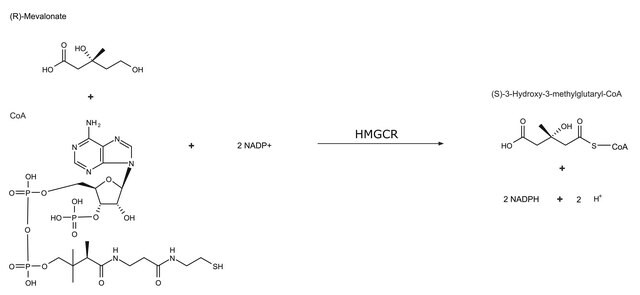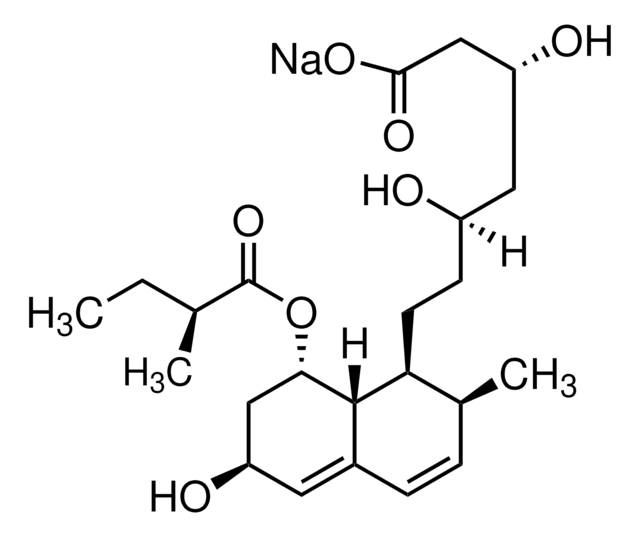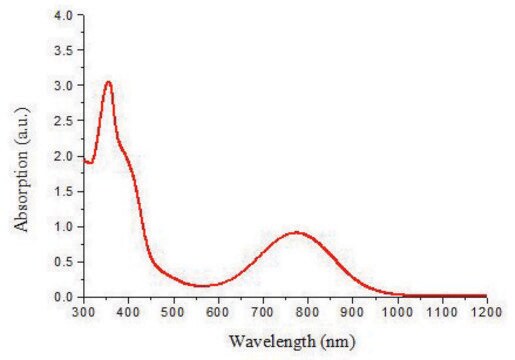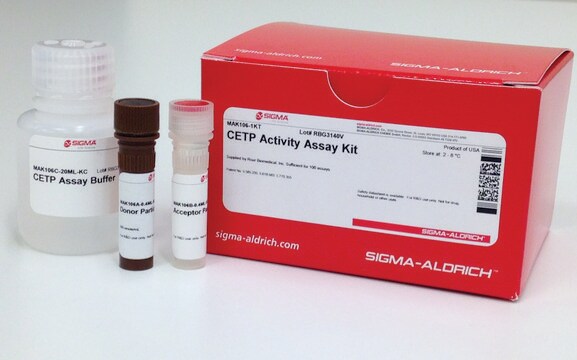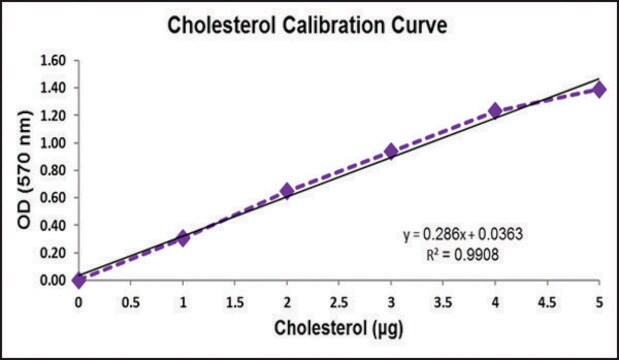CS1090
HMG-CoA Reductase Assay Kit
sufficient for 30 assays (1 mL), sufficient for 100 assays (200 μL)
Synonyme(s) :
HMGR Assay Kit
Se connecterpour consulter vos tarifs contractuels et ceux de votre entreprise/organisme
Sélectionner une taille de conditionnement
Sélectionner une taille de conditionnement
Changer de vue
About This Item
Code UNSPSC :
12161503
Nomenclature NACRES :
NA.28
Produits recommandés
Utilisation
sufficient for 100 assays (200 μL)
sufficient for 30 assays (1 mL)
Niveau de qualité
Conditions d'expédition
dry ice
Température de stockage
−70°C
Informations sur le gène
human ... HMGCR(3156)
Catégories apparentées
Description générale
The HMG-CoA Reductase Assay Kit is an important tool for the basic research of cholesterol and other related metabolic pathways.
Application
The HMGR activity kit is designed for the detection of HMG-CoA reductase activity. A major function of the kit is to screen for various inhibitors and activators of the purified catalytic subunit of the enzyme, HMG-CoA reductase, which may play a crucial role in therapeutics. The assay is based on the spectrophotometric measurement of the decrease in absorbance at 340 nm, which represents the oxidation of NADPH by the catalytic subunit of HMGR in the presence of the substrate HMG-CoA.
Actions biochimiques/physiologiques
HMGR (3-hydroxy-3-methylglutaryl-CoA reductase) is a transmembrane glycoprotein located on the endoplasmic reticulum. This enzyme catalyzes the four-electron reduction of HMG-CoA to coenzyme A (CoA) and mevalonate, which is the rate-limiting step in sterol biosynthesis. The activity of HMGR is controlled through synthesis, degradation, and phosphorylation in order to maintain the concentration of mevalonate derived products. In addition to the physiological regulation of HMGR, the human enzyme has been targeted successfully by drugs in the clinical treatment of high serum cholesterol levels. Controlling serum cholesterol levels has an important therapeutic role since hypercholesterolemia often leads to the development of atherosclerosis and subsequently to cardiovascular pathologies, which might result in myocardial infarction and stroke. It has been suggested that a disturbance of cholesterol homeostasis contributes to the development of a chronic inflammatory state.
Composants de kit également disponibles séparément
Réf. du produit
Description
FDS
- N6505β-Nicotinamide adenine dinucleotide 2′-phosphate reduced tetrasodium salt hydrate, ≥95% (HPLC) 25 mgFDS
Code de la classe de stockage
11 - Combustible Solids
Faites votre choix parmi les versions les plus récentes :
Déjà en possession de ce produit ?
Retrouvez la documentation relative aux produits que vous avez récemment achetés dans la Bibliothèque de documents.
Les clients ont également consulté
G A Holdgate et al.
Biochemical Society transactions, 31(Pt 3), 528-531 (2003-05-30)
The statins are inhibitors of 3-hydroxy-3-methylglutaryl CoA (HMG-CoA) reductase (HMG-CoAR), and are utilized to decrease levels of atherogenic lipoproteins in patients with, or who are at high risk of, cardiovascular disease. This study describes the inhibition of a recombinant, catalytic
A J Koning et al.
Molecular biology of the cell, 7(5), 769-789 (1996-05-01)
In all eucaryotic cell types analyzed, proliferations of the endoplasmic reticulum (ER) can be induced by increasing the levels of certain integral ER proteins. One of the best characterized of these proteins is HMG-CoA reductase, which catalyzes the rate-limiting step
Matteo Mozzicafreddo et al.
Journal of lipid research, 51(8), 2460-2463 (2010-04-27)
Radioisotope-based and mass spectrometry coupled to chromatographic techniques are the conventional methods for monitoring HMG-CoA reductase (HMGR) activity. Irrespective of offering adequate sensitivity, these methods are often cumbersome and time-consuming, requiring the handling of radiolabeled chemicals or elaborate ad-hoc derivatizing
E S Istvan et al.
Biochimica et biophysica acta, 1529(1-3), 9-18 (2000-12-09)
In higher plants, fungi, and animals isoprenoids are derived from the mevalonate pathway. The carboxylic acid mevalonate is formed from acetyl-CoA and acetoacetyl-CoA via the intermediate 3-hydroxy-3-methylglutaryl coenzyme A (HMG-CoA). The four-electron reduction of HMG-CoA to mevalonate, which utilizes two
Rosana Aparecida Manólio Soares et al.
International journal of molecular sciences, 16(2), 4150-4160 (2015-02-19)
The objective of this study was to identify the major peptides generated by the in vitro hydrolysis of Amaranthus cruentus protein and to verify the effect of these peptides on the activity of 3-hydroxy-3-methyl-glutaryl-CoA reductase (HMG-CoA reductase), a key enzyme
Articles
HMG-CoA Reductase (HMGR) Assay Kit
Notre équipe de scientifiques dispose d'une expérience dans tous les secteurs de la recherche, notamment en sciences de la vie, science des matériaux, synthèse chimique, chromatographie, analyse et dans de nombreux autres domaines..
Contacter notre Service technique